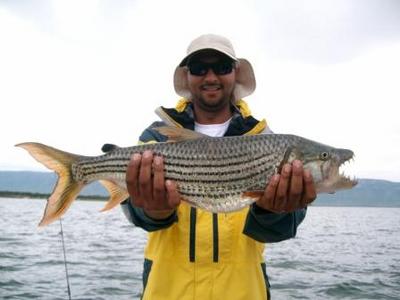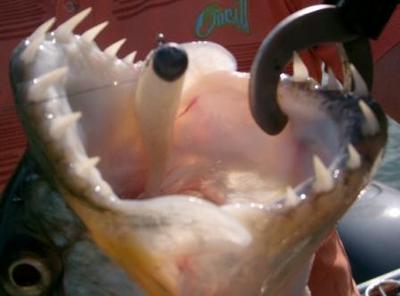I have observed that a big portion of the anglers targeting Tiger Fish at Lake Jozini are Deep Sea anglers. Jozini provides an alternative when the weather goes wrong at Sodwana and is only an hour's drive away.
There are many ways that an angler can target Tiger Fish and in this article I am going to write about targeting these magnificent freshwater game fish using artificial soft plastic baits, this is a relatively new method very similar to saltwater drop shot and is an extremely effective. Since I started fishing for Tigers this way I have not used any other method it is so effective, except for fly fishing.
About Tiger Fish
The Tiger Fish (Hydrocynus Vittatus) is a major freshwater angling game fish and can easily be recognised by the bluish sheen on its back, a series of parallel longitudinal black stripes, intensive yellow to blood red fins with trailing black edges and a series of 8 large protruding sharply pointed teeth on each jaw.
Tiger fish are ferocious and aggressive apex predators, and are a hard fighting freshwater game fish. An awesome fish to catch on light tackle and fly fishing equipment.
Tiger Fish are indigenous to Africa.
A local name given to the Tiger Fish is Striped Water Dog.
About Lake Jozini
Lake Jozini, also known as Pongolapoort Dam is situated in the North Eastern corner of Kwa Zulu Natal, South Africa, near the towns of Pongola and Jozini, bordered by the Phongola Game Reserve, and several other Game Reserves and the Lebombo Mountains. Lake Jozini is fed by the Pongola River and is South Africa's premier Tiger Fish destination.
Lake Jozini is the most southern lake and river system in Africa where Tiger Fish occur. The main target species here are the Tiger Fish which can get up to 8.5Kgs (18.7lbs) for the large Tiger Fish specimens, there are many Tiger Fish in the 900gr (2lb) range with the average Tiger fish being caught in the 1 - 4Kg (2.2-8.8lb) range, and specimens in the 5Kg (11lb) range are sometimes caught. There are also 27 other recorded fish species in Lake Jozini.
Lake Jozini and the whole Maputuland area is just one of those places where you can get back to your roots in Africa, unwind and refresh yourself. The area around the lake is magnificent and naturally wild and you are able to view many species of Birds and Game whilst fishing.
Whilst fishing here on the boat I have viewed Elephants, Giraffes, many species of Buck, Zebra, Rhino, Hippopotamus, Buffalo, Crocodiles, Large Iguana, many Bird species and much more, and to do this from an open boat on the water is the best way.
The Summers are very hot, the Winters are mild, Spring and Autumn have a simply fantastic Climate.
The Lake is huge and resembles a smaller version of Lake Kariba, there is a wide choice of camping facilities, caravan parks, self catering chalets, bed & breakfasts and 4 & 5 Star lodges like Shayamoya in the area. There are also many game parks with the Big 5 and Reserves around the area and it is not too far to Cape Vidal, St. Lucia, Kosi Bay, Kosi Lakes, St. Lucia Lakes, Sodwana Bay, Mkhuze Game Reserve, Thembe Elephant Park and Hluhluwe Game Reserve. The Swaziland border is right there by Golela and a small part of the lake is in Swaziland, the Mozambique border is not too far away from the town of Jozini.
When you are there it is recommended to take the opportunity to explore the area and game parks around.
Understanding Tiger Fish
Tiger fish are apex predators and predominantly visual hunter's, they are gregarious feeders and highly opportunistic. You will often find Tiger Fish in the same areas that you would find Bass, but unlike Bass they do not hide in the structure in wait of prey but hunt more like saltwater game fish patrolling the edges of structures where bait fish and other food sources would be hiding. Tiger fish will also cover large areas in small groups and the larger specimens will hunt alone, this means that if you choose a structure a Tiger Fish is sure to pass by at some point in time.
Where to find Tigers at Jozini
This is the million Dollar question, and the answer is that they are all over the dam, they cannot leave or migrate.
In the River Section you will find Tiger fish along the edges of the weed beds, in the little bays along cliffs and rocky points, by submerged trees and stumps and as this section is not deep and only goes to about 12m you will also find tigers in the mid water section. The river section is a popular choice and not to far from the launch area. Be warned that the river section is full of crocodiles of which some are huge, and you must always keep clear of the hippos who do not like being disturbed and will chase you on your boat if you come to close, hippos are dangerous and will kill you with no regrets. At the end of the river section there is a train bridge and you are not allowed past this point.
The Bay Section has always produced good fish and there are a lot of weed beds in the area which always produce good fish, on the western side there are the shallow weed and grass beds; on the northern side there are a lot of stumps; and on the eastern side there are some good grass and weed points. Points always work well. The river and bay sections are good in the Tiger spawning season in September to November.
The Main Dam is huge and as you come out of the bay area on the eastern side the is a large flat and shallow area with isolated submerged structure which often hold good fish, on the western banks there are lots of weed beds extending far in to the dam and the it is not deep, there are also some nice bays along the western banks and a lot of dead trees. The top northern section of the dam is in Swaziland. The middle section of the main dam is deep and along the Lebombo mountain's there are a lot of steep rocky banks, little bays with trees and some weed beds. Again beware of the hippos. The main dam fishes well through out the year and in the winter months you will find Tiger fish in the deeper water. The wind can blow at Jozini and the main dam can become like deep sea fishing with waves up to 2m and closely spaced, then it is better to stay in the river and bay section which is more sheltered.
The Gorge is one of the most beautiful places of the dam and often you will find yourself isolated here with just you, the water and the nature around you, it is a long boat ride of almost 20Km from the launch site, it is a must see area. The gorge gets to about 50-60m deep in the middle section, there are a lot of steep rocky banks and drop offs where you will find fish, and there are many bays with good structure, and with all the bays there are also many productive points. There is some weeds here but not to much.
Big Tigers are found here, and the fishing can be hard but rewarding, with this area being productive in the winter.
RIGGING AND FISHING THE LURES MY STYLE
Leaders
You can fish with or without a steel trace; personally I prefer to fish without a steel trace and use a 300mm 12-20lb Flouro Carbon leader with a 100mm 30lb Flouro Carbon Bite trace onto 10-16lb braid or even use a straight 20-30lb Flouro Carbon leader, you will get more strikes like this, but you also risk getting bitten off more often. I prefer the flouro as it is a little more resistant to abrasion than mono; you will also need to be really sharp when you get your strikes to set the hook and keep the line away from the Tigers teeth.
To minimise the risk of your lure being bitten you can use a short 100mm No. 3 stainless steel wire trace tied to a 200-300mm 12-30lb flouro or mono leader using an Albright knot and then 10-16lb braid or even just use mono as your main line if you have no braid. A long steel trace will serve no purpose and will upset the movement of your lure. I prefer the braid as you have direct contact with your lure and zero stretch when you need to set the hook fast, and believe me you need to set it fast.
Surface Fishing for Tigers
I will start with rigging soft plastic lures weightless and fishing them on the surface, this is my favourite way and the way I rig the lures is pretty much snag free, and you get to see your lure swimming, the fish chase and hit your lure whilst fishing.
With this method I use a 2/0 to 5/0 wide gape Bass hook depending on the size of your lure, which must have an acute angle on the bend by the eye to hold your lure in place. I then rig the lure the same way that one would rig a Bass lure, but there are 2 things I do differently, I do not bury the point of the hook in the lure as it is then very difficult to get the hook to penetrate the tigers hard mouth, I also use a drop of super glue on the shank of the hook by the eye to hold the lure in place as tigers have nasty habit of pulling your entire lure off your hook.
Lures that I like to use are paddle tail lures, flukes and any fish shaped lure. My favourite lures are the Strike King 4" Glass Minnow paddle tails which have produced more tigers than any other lure I have used. The plastic that the Strike King and Z-Man lures are made from is much more resistant to the tiger's sharp teeth when compared to other plastics and so last much longer and you can catch several fish on one lure. It is my opinion that the movement of your lure is the most important factor and colours and other features are secondary. Tiger fish like bright colours, and I think this is because they are visual predators and here are some colours that I have found work very well: Pearl, White, Green, Pearl/Blue Glimmer, Space Guppy, Green/Gold Flake, Green/Silver Flake, Baby Bass, Chartreuse, Bright Green, Pink, Electric Chicken, Red and any of these colours in two tone creating a contrast. Some plastics float and some sink slowly and both can be used, the floating ones will sit on the surface whilst the sinking ones will move in the surface.
For fishing the weightless lures I prefer a 6'6" Medium to Medium Heavy rod with a fast action and definitely a spinning reel set up and a lighter braid like 10lb. I personally use a Shimano Crucial 6'8" medium spinning rod with a Penn Sargus 2000 spinning reel and 10lb Double X braid. This kind of set up will allow you to cast these light weights well, and still have the power to land you a larger fish.
Fishing these surface lures is exciting and you can cast to the edges of rocky banks, around trees and stumps, over submerged structure, into weed beds, next to and parallel to weed beds, into open water, into channels and water pockets by weed beds, and along flat banks and shallow waters and grass areas.
Your retrieves can vary from fast to slow and you can even just leave them drifting to get a strike, with fluke and fish shaped soft plastics you should use a twitching retrieve or twitch and pause retrieve which will get the lure darting from left to right, with paddle tail lures that have built in action you can just do a flat retrieve or twitch and pause, or flat reel and pause. Vary your speeds until you find one or two that gets you strikes and then you can stick with these. Sometimes the Tiger Fish want it fast, and sometimes dead slow, and other times in between, so you must experiment.
Surface fishing works best early morning, late afternoon and in overcast or cooler conditions, I find that when the water is flat or clear faster retrieves work better.
Fishing for Tigers Drop Shot Style
Here you pretty much use the same lures and colours that are used for surface fishing detailed above; the difference is in the rigging. Here we use jig heads from 1/8 ounce to 1 ounce with size 1 to size 6/0 hooks according to your soft plastic bait size. The best sizes are lures in the 4" and 5" size fished with ounce jig heads and size 2/0 hooks.
It is important to rig your lure straight and you must use some super glue to keep the lure properly secured so the Tiger Fish does not steal it.
Paddle tail lures and flukes are very effective for Tiger Fish and can be fished with a flat retrieve; or a twitch and pause retrieve; you can fish these fast or slow depending on your depth. You can let them sink and retrieve them very slowly along the bottom of jig them up and let them fall again. You can cast them at rocky ledges, in front or parallel to weed beds, around trees and stumps, around isolated structure, submerged structure and even on flat bottoms. I have found very few Tiger fish deeper than 12m. You must vary the speed of you retrieves from fast to dead slow until you find what get the strikes.
Fighting and Landing Tiger Fish
When fishing for Tiger Fish you must accept the fact that you will loose many fish, some will come loose on the jump, whist others will tie you up in structure and many will bite you off regardless of a steel trace.
Here are some pointers that can help you get your Tiger Fish onto your boat. When fishing keep your rod tip down and close to the water surface. When you get your strike give one solid hit immediately bringing your rod tip into the water, ensure when you strike that you give no slack on your line.
At any point if you give slack you will loose your fish, so be sure you do not make the fatal mistake when striking so hard that you give slack line. You must strike and reel simultaneously keeping your line tight.
Almost always straight after you strike your Tiger fish is going to go airborne and give you an aerial display, and so as you strike you must get your rod into the water so that the water maintains pressure on your line, if the fish is in the air and your rod tip in the air you will loose pressure on your line and loose your Tiger.
You then fight him keeping your rod tip in the water until you get him to the boat, he will run around the boat a while and while and even go airborne a few more times. Do not rush him, fight him. Only when you see he is ready for the net do you lift you rod up to around 45 deg. with at least 1m of line out from your rod tip and lift his head out the water to net him. Then use a boga Grip to handle your fish.
Be careful of those teeth, they are razor sharp.
Catch, Photo, Release (CPR)
Catch, Photo, Release is a policy strictly enforced on my boat and all my Tiger Fish Charters and Guiding, and to my dismay I see so many Tiger Fish slaughtered for no reason. I will not even support a competition that kills Tiger Fish. Tiger Fish are indigenous fish in our waters, and anglers need to get their attitudes right about killing fish and start taking responsibility for our natural resources. The days of killing fish are over, it is time to change.
All the fish shown in this article where safely released.
I hope that this article will assist you when hunting Tigers, and trust that you will take the conservationist approach and start caring for our environment and practising catch, photo, release.




